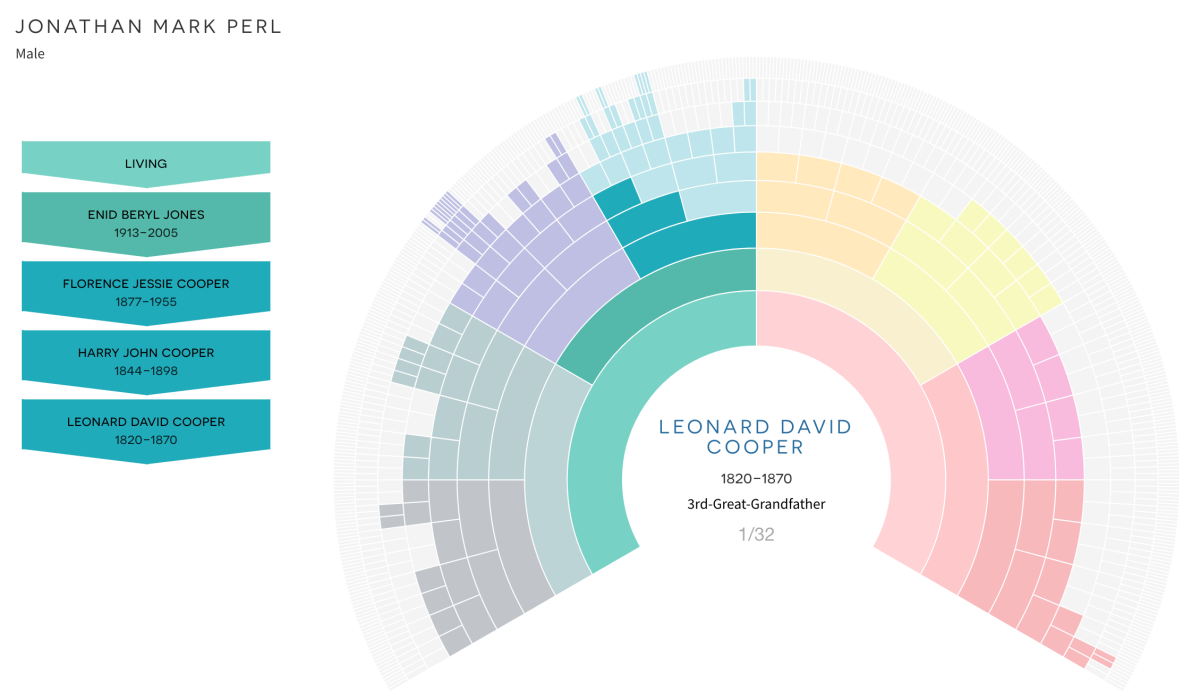DNA Painter is known for chromosome mapping, but also includes ancestral trees, a useful interface for visualizing your family line (aka pedigree).
To create your ancestral tree, you can select your GEDCOM file and have DNA Painter extract your direct line. Or if you prefer, you can enter it manually. Trees are private by default but you can optionally share them.
The ancestral tree interface offers several features that are tailor-made for DNA work. In this article I’ll summarise the most useful features and then provide a brief introduction on how to get started.
Useful features
1. Figure out how complete your tree is
In an ideal world, both you and your DNA match will have complete trees to six or more generations. But in practice this is very unlikely to be the case! We will connect to many of our matches via common ancestors who are beyond the tips of our tree. Some of these connections may remain out of our reach, but it’s helpful to understand the nature of the challenge we’re working with.
Within a tree at DNA Painter there’s a tool to help you see how complete it is. Simply click on ‘Tree completeness’ to see an overlay showing tree completeness at each generation.
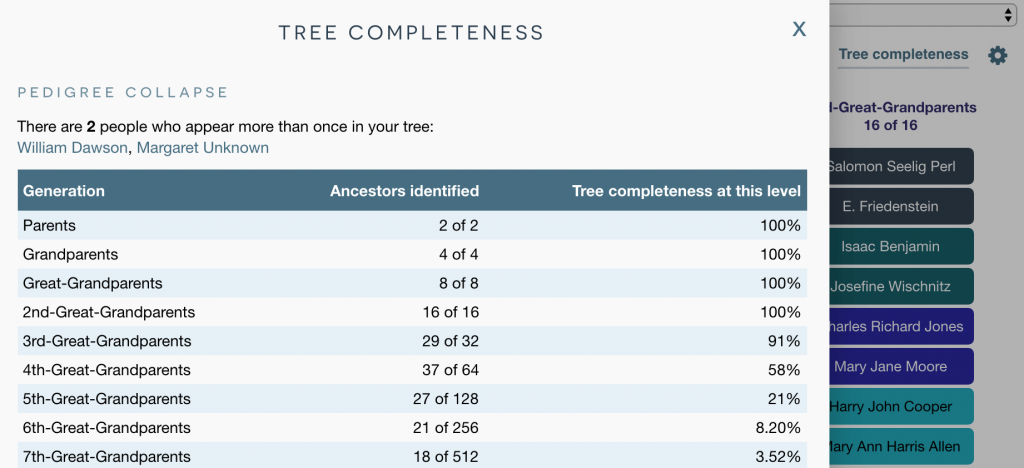
2. Track your genetic family tree
Due to autosomal DNA inheritance patterns, the amount of DNA we inherit from ancestors beyond our parents can vary significantly. After four to six generations, it’s likely the ancestors will start to “drop off” your genetic family tree. By this I mean that while this person is still your genealogical ancestor, you may not have inherited any discernable DNA from them at all.
Amazingly, it’s now 11 years since Blaine Bettinger wrote his article Q&A: Everyone Has Two Family Trees – A Genealogical Tree and a Genetic Tree. If you’re not familiar with the concept, I’d recommend reading this now.
DNA Painter lets you mark any ancestor as being in your genetic family tree. To give you a simple example:
- my mother’s paternal first cousin agreed to test for me, and we share about 650cM of DNA.
- For me, this is sufficient evidence to confirm that we are genetically related in a way that matches our paper trail
- I can therefore mark my paternal grandfather as a genetic ancestor.
- I’m also comfortable with marking his parents as genetic ancestors, since this 650cM will be a mixture of DNA from each of them.
Having done this for all my other identified matches, I can now filter my tree to show genetic ancestors only.
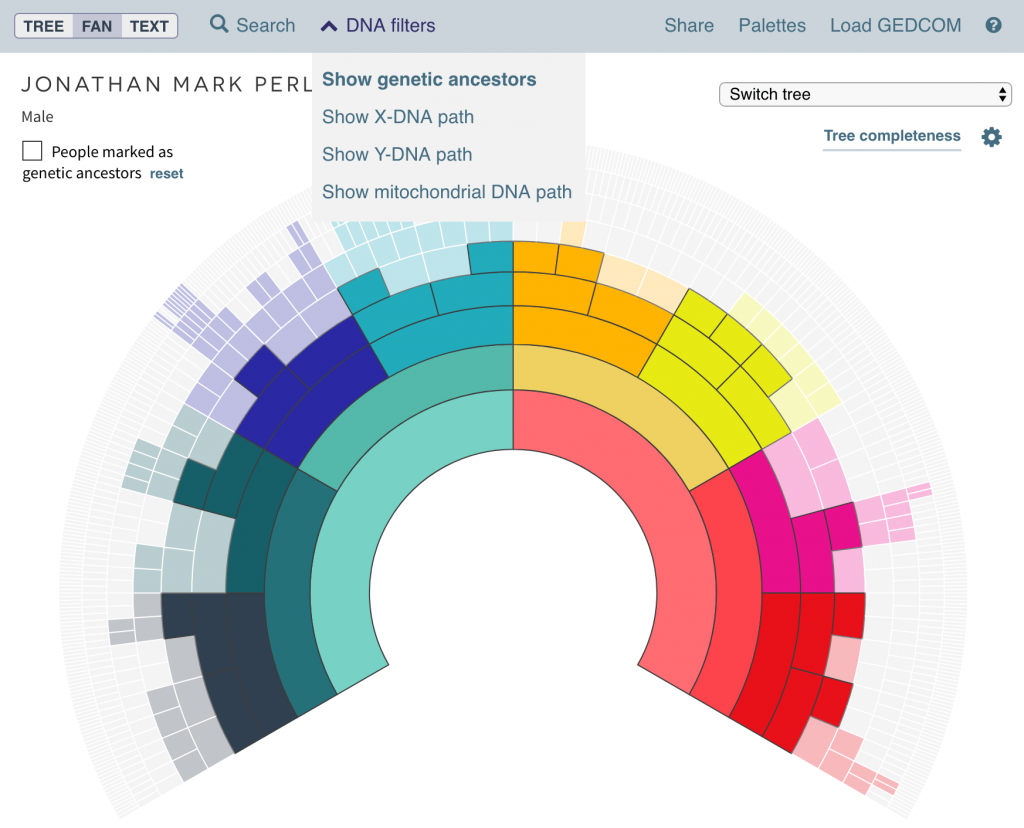
This is useful because it demonstrates at a glance which areas of my tree have not yet been corroborated with DNA evidence. This might be because the descendants on this line are under-represented in the testing pool; perhaps I inherited less DNA than average from them; or perhaps my tree is wrong!
Overall, this feature lets me keep a virtual ‘scorecard’ on how I’m doing in my quest to validate my tree using my DNA results.
Please note: It’s important to exercise caution when working with more remote matches. If for example you’ve identified 8cM shared with a fifth cousin, do you really know that this segment was indeed inherited from your known common ancestor? Or could there be another connection you’re not aware of?
3. Overlay inheritance paths
You can also overlay inheritance paths for the different types of DNA. When you see the inheritance paths overlaid on your own family, it becomes easier to understand them.
For example: I have a 66cM match on the X chromosome. Without even looking at shared matches, I can look at my X-chromosome inheritance path to see the possible sources of this X DNA within my own direct line. I have only one X chromosome and it came from my mother. The fact that males inherit X DNA only from their mothers helps me to narrow down the possible lines more quickly.

Y and mitochondrial inheritance paths are more straightforward, but can also be helpful. For example, if you identify a potential common ancestor who is in the Y or mitochondrial DNA inheritance path for both you and your match, you could examine haplogroups to see if they correspond.
A new feature related to this is coming soon:
- If you’ve uploaded your mitochondrial and/or Y DNA to mitoydna.org, you will be able to associate your MitoYDNA kit numbers with your DNA Painter tree.
4. Visualize pedigree collapse in your tree
This will be more relevant to some than others, but if you’ve identified any pedigree collapse in your tree, the fan view offers a compelling (and as far as I know unique) way to visualize this. By pedigree collapse, I mean situations where an ancestor appears more than once in your tree due to intermarriage.
If you import your GEDCOM, a pedigree collapse report will automatically be generated in the ‘tree completeness’ overlay. What’s more: if you hover over any ancestor who appears more than once in your tree, DNA Painter will highlight all the other paths to places where they appear, along with a listing of the different ways you’re related to them.
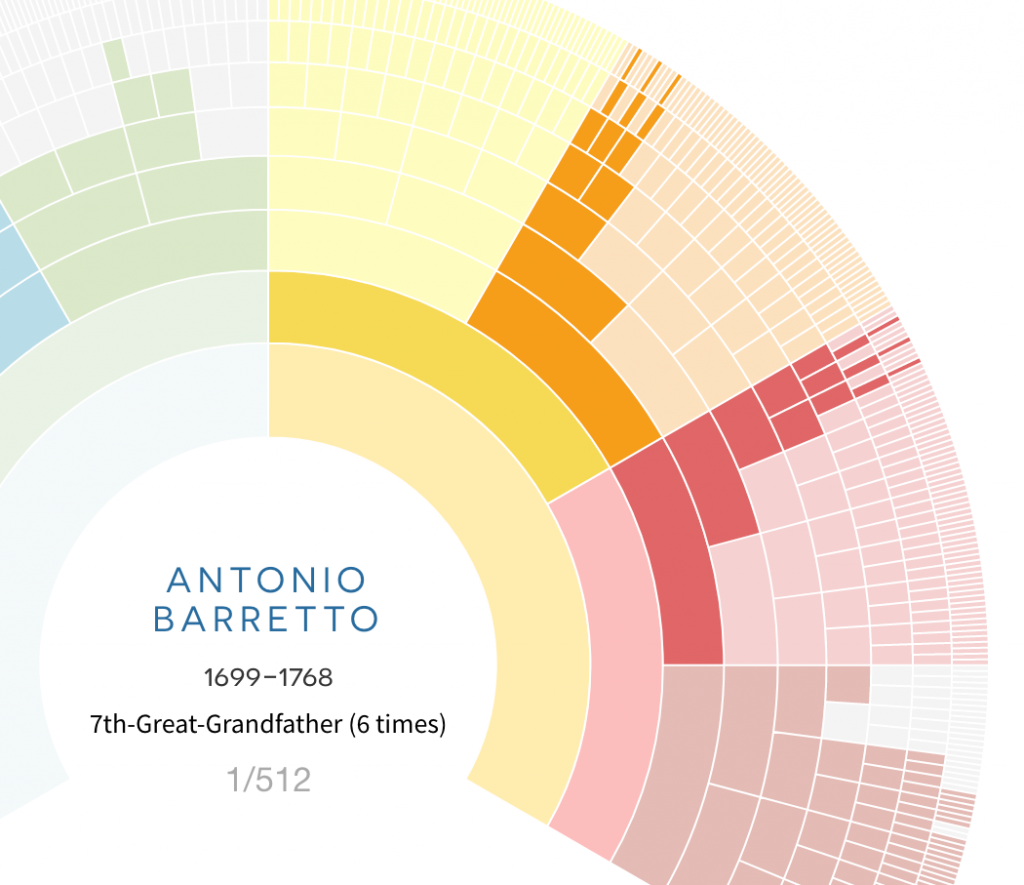
5. Share your ancestral trees with family members and DNA matches
By default all trees are private, but if you would like to share your tree with matches, it’s quick and easy to do so by clicking ‘Share’, turning sharing on, and copying and pasting the link. You can also link specifically to the tree, fan or text view. By default, the site hides all living people. If you would like to include living people, please click the appropriate option in the share dialogue.

I’m hoping this feature can go some way to reducing the friction that can occur when you try to share a tree on another hosted platform.
6. Zero in on relevant names and places
When you visit the tree of a match, you’re most likely looking for names and/or ancestral places that overlap with your known tree. The same applies to matches visiting your tree.
DNA Painter offers a simple search that will quickly allow you to identify names or places of interest. The fan view also allows you to see at a glance which lines of the tree are less well researched. So if you *don’t* see any obvious common names or places, you can investigate any gaps in the tree where common ancestors might be.

7. Annotate brick wall lines
If you’re working on your own ancestral pedigree, the chances are that on some lines you might have some clues as to what lies beyond. You might have several DNA matches with the same family in their tree, or perhaps you might have some tentative or unproven genealogical clues.
You can enter this information into your DNA Painter tree, either in the notes field for each person, or if you have surnames, as ‘surname clues’. For example, I have an Irish line where the middle name ‘Ritchie’ is used consistently. In that same line, I know of two males named ‘Norman Howard Dunlop’. I don’t have any known ancestors called Ritchie or Howard, but I can hypothesise that these names might lie just beyond the tips of my tree on these lines.
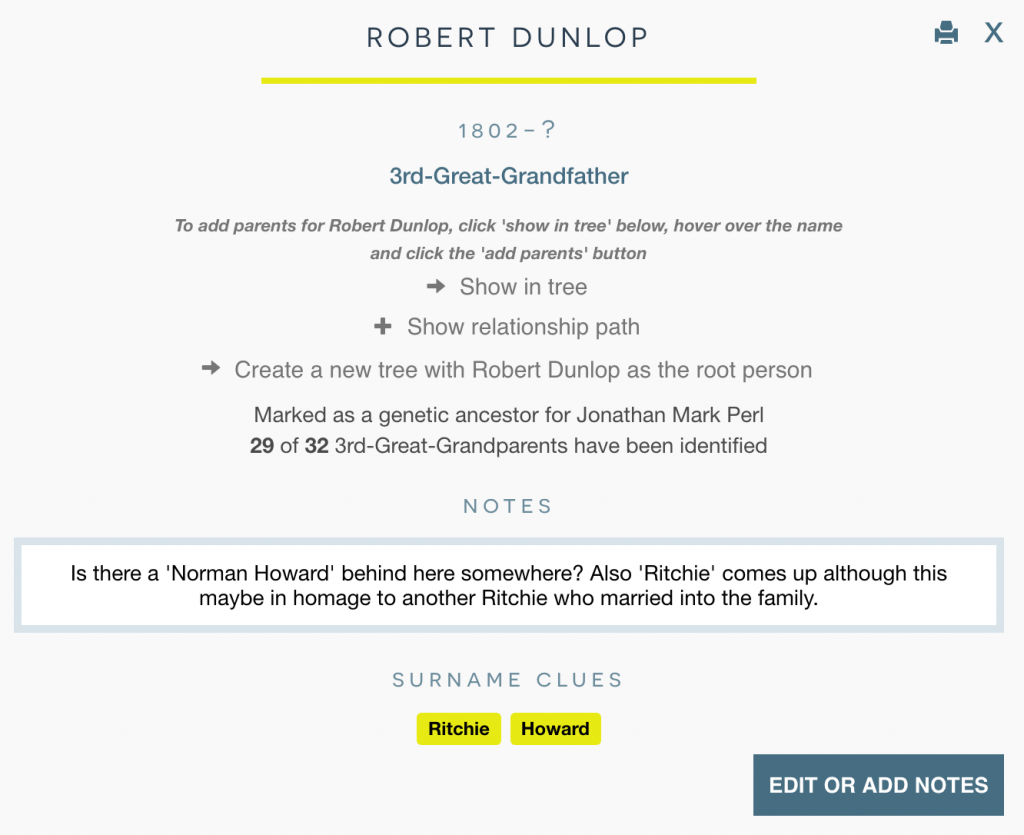
By adding these names as surname hints in the appropriate place in my tree, I can signal to other researchers that I think these names might lie beyond. This way, if a DNA match is reviewing my tree, they will have additional potential evidence to help us figure out the connection.
8. Customize colours
When you create or import a tree, it will appear with the default colour palette. If you prefer, you can switch to another set of colours, or edit colours individually.
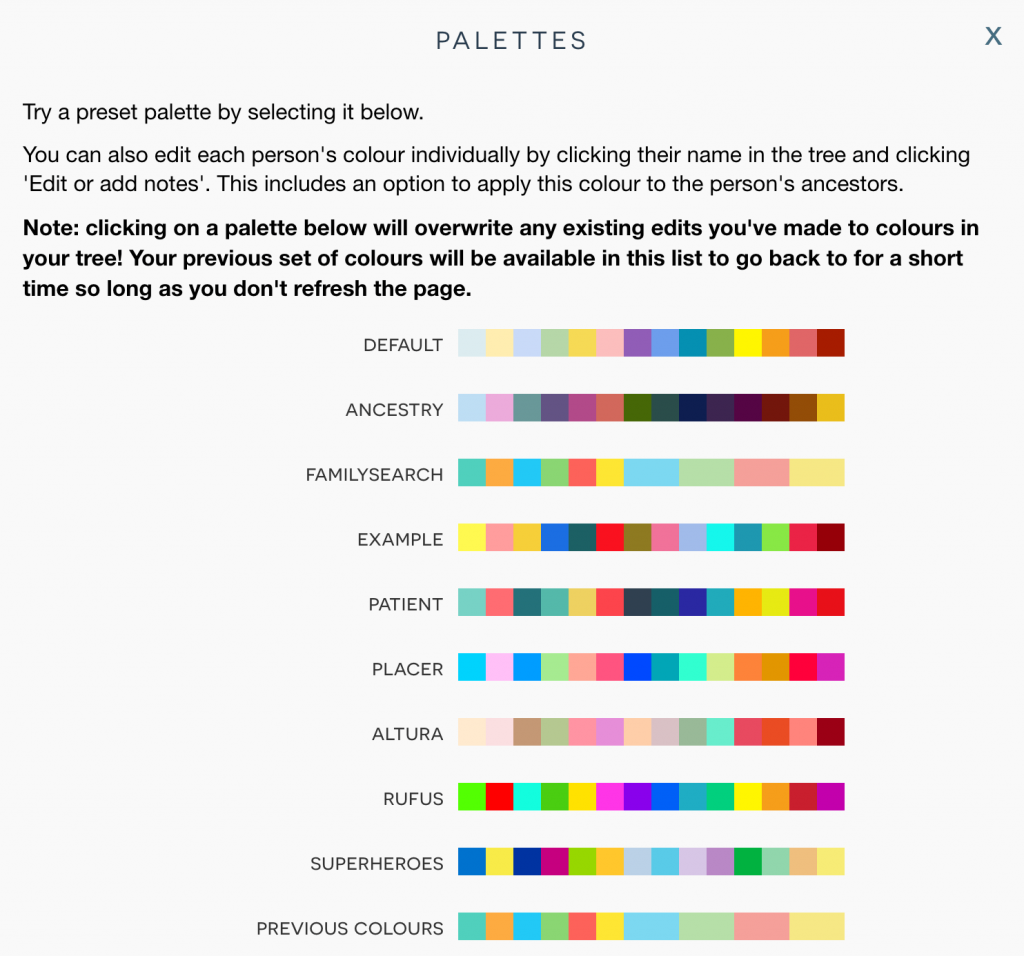
You can create your own custom palette quite easily by editing someone in your tree, clicking the colour palette and checking ‘apply this colour to all direct ancestors of this person’
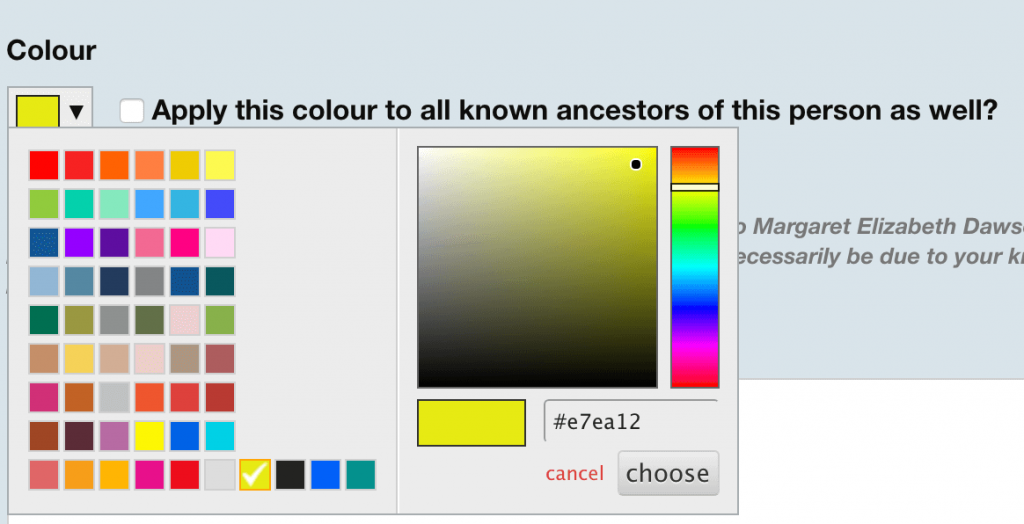
How to create ancestral trees at DNA Painter
There are a few simple steps. If you haven’t already, please create an account.
Create your tree
Once you’ve logged in, click on the ‘Ancestral trees’ tab on the homepage and click ‘Create a new tree’.
Option 1: manual entry
You will see a default tree with generic names (e.g. ‘Grandfather’, ‘Great-grandmother’). You can now enter people into your tree manually by clicking on a node and typing their name.
Option 2: GEDCOM import
Or if you have your tree hosted on a website or locally within some genealogy software (e.g. FamilyTreeMaker or Rootsmagic), you can export a GEDCOM file and import this into DNA Painter.
Please note that in order to import beyond 4th great-grandparent level, you will need to subscribe. You can also import to 4th-great-grandparent level and then add other ancestors manually.
To import a GEDCOM, simply click ‘Load GEDCOM’ at the top right. This will bring up an overlay, and you can then drag and drop your file into the dotted area, or click to browse for it.

Choose the person whose line to extract
The site will then ask you to select the person whose direct line you’d like to extract. By default, all living people will be imported as ‘Living’, but if you’d like to include their names, just click this option.
Coming soon to ancestral trees
You will be able to link your chromosome map to a specific person within your tree in order to sync colours between the tree and the chromosome map (and lots of other more interesting synchronisations).
Next steps
Try creating a tree via the ‘Ancestral Trees’ tab on the DNA Painter homepage. There’s also an FAQ you can check out if you’d like to read more before you start.
Contact info: @dnapainter.bsky.social / jonny@dnapainter.com
